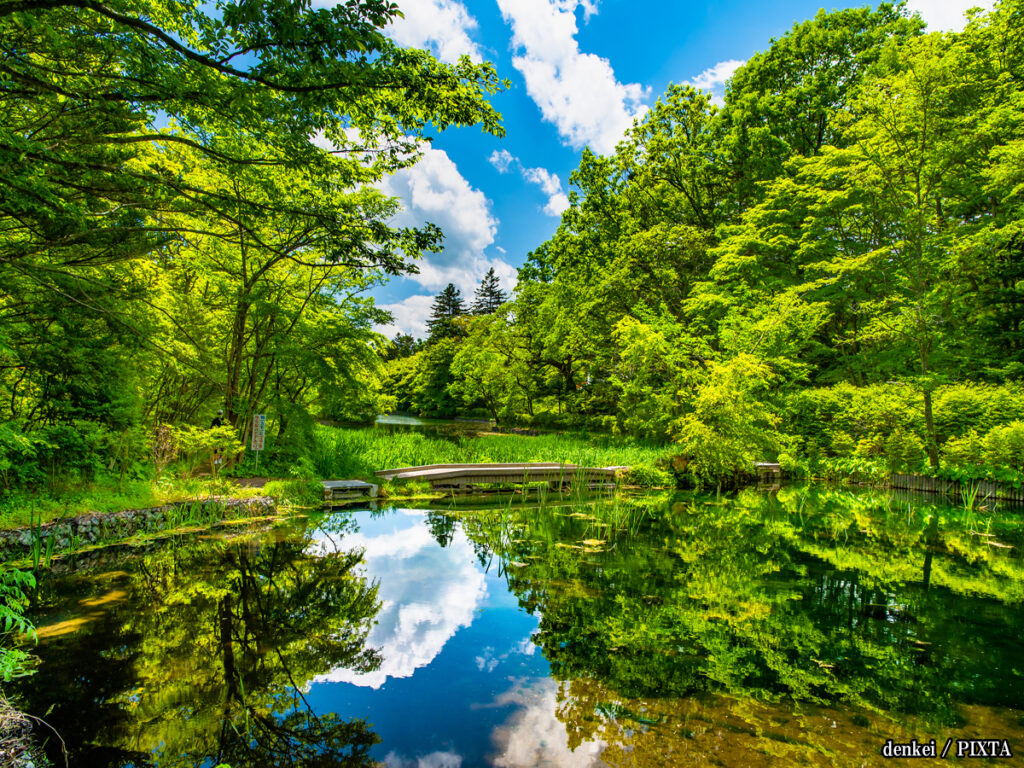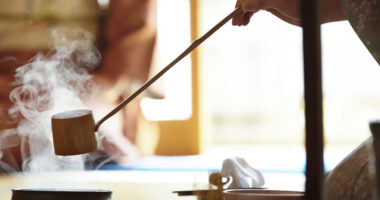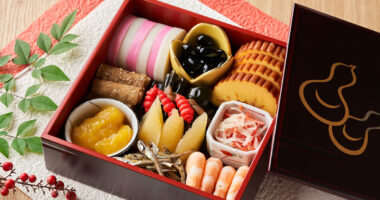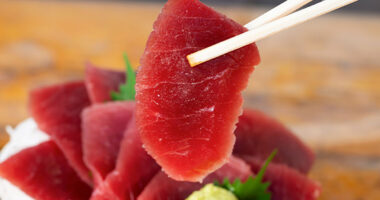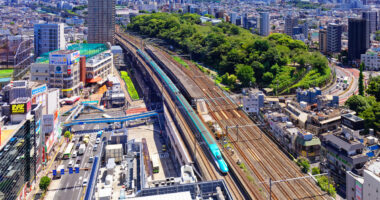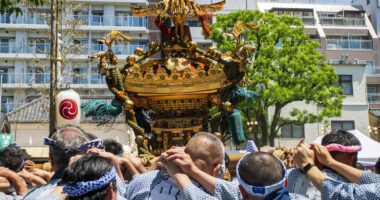- Karuizawa: a cool haven amidst Japan's summer heat
- A go-to destination for a peaceful retreat
- From mountain village to Japan’s iconic summer escape
- Early history of Karuizawa
- Karuizawa’s transformation: summer retreat for elites
- Railway access to Karuizawa and transformation into a modern resort town
- Prestigious resort: continuing the legacy of Karuizawa
- Architectural evolution: the influence of Western missionaries and diplomats
- Karuizawa's role in Japanese culture
- Modern-day Karuizawa
- Mini travel guide to Karuizawa
Karuizawa: a cool haven amidst Japan’s summer heat
Karuizawa, a picturesque town nestled in the mountains of Nagano Prefecture, is widely regarded as one of Japan’s best summer resorts. Known for its cool climate, beautiful nature, and peaceful atmosphere, Karuizawa has attracted visitors for over a century. Originally, it was a retreat for Tokyo’s elite. Over time, it became a popular destination for both locals and international tourists. One of the best seasons to visit Karuizawa is summer, as its cool temperature provides a refreshing escape from the city’s heat.
A go-to destination for a peaceful retreat
The town’s importance in modern Japanese tourism is something to celebrate. It’s become a place where people can unwind, indulge in luxury, and enjoy the great outdoors. From hiking and cycling to browsing charming boutiques, there’s something for everyone. With its rich history, beautiful Western-style architecture, and the influence of foreign missionaries, Karuizawa has become a go-to destination for those seeking a peaceful retreat.
If you want to experience this heaven on earth, then stick to the end. This article will delve into the fascinating history of Karuizawa, tracing its evolution from a quiet mountain village to one of Japan’s leading summer resorts. By exploring the town’s origins, influential people, and key events, we’ll uncover the story of how Karuizawa became the iconic destination it is today.
From mountain village to Japan’s iconic summer escape
Early history of Karuizawa
The early history of Karuizawa dates back to the Edo period (1603–1868) when it was a small, quiet village surrounded by dense forests and natural beauty. Located in the mountains of Nagano Prefecture, it was initially a place with little outside attention. Thus, it was mainly inhabited by farmers and small communities.
Karuizawa was known for its cool climate and abundant natural resources. The pleasant atmosphere of Karuizawa made it an ideal place for travelers to rest along important trade routes, such as the Nakasendo Highway, which connected Edo (modern-day Tokyo) to Kyoto. While it wasn’t a major center of commerce, Karuizawa’s natural beauty and strategic location made it a quiet stop for travelers. It wasn’t until the late 19th century that Karuizawa began to gain recognition as a destination for relaxation.
Karuizawa’s transformation: summer retreat for elites
The turning point came in the Meiji era (1868–1912) when the town was discovered by Western missionaries. The cooler weather and refreshing environment proved ideal for escaping the hot, humid summers in Tokyo. Since this picturesque town had the potential to offer a retreat for those seeking a break from the city, foreigners and wealthy Japanese began to build villas and summer homes in the area, which further cemented Karuizawa’s status as a getaway spot. This marked the beginning of Karuizawa’s transformation, as it gradually evolved into a place of leisure and retreat, particularly for the Western expatriate community.
Railway access to Karuizawa and transformation into a modern resort town
Soon after, the arrival of the railway in 1886 dramatically changed Karuizawa’s accessibility. The newly constructed railway line connected it to Tokyo, allowing more visitors to reach the town. The influx of visitors led to the construction of Western-style hotels, shops, and leisure facilities. This gave Karuizawa its distinctive blend of Japanese and Western influences, which continues to define the town today. Thus, in the late 19th century, Karuizawa became a symbol of Japan’s modernization. It became a meeting point for Japan’s elite, intellectuals, and artists, marking its place in Japan’s social and cultural history before its rise as a premier resort town.
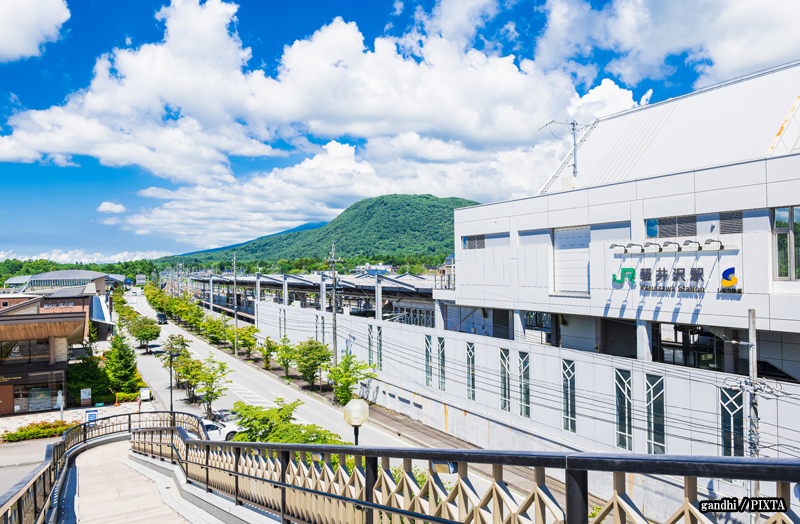
Photo for illustrative purposes
Prestigious resort: continuing the legacy of Karuizawa
Prominent figures such as members of the Japanese Imperial Family began visiting Karuizawa regularly. Their presence not only elevated the town’s status but also encouraged the aristocracy and high-ranking military officers to follow suit.
Later, the construction of golf courses further enhanced Karuizawa’s appeal as a resort for the aristocrats, offering recreational activities alongside the town’s natural beauty. This combination of luxury and leisure solidified Karuizawa’s reputation as a premier summer escape for Japan’s upper class, laying the foundation for the town’s continued popularity as a tourist destination. Thus, Karuizawa’s role as a summer haven helped shape its legacy as one of Japan’s most prestigious resorts.
Architectural evolution: the influence of Western missionaries and diplomats
The arrival of Western missionaries and diplomats in the late 19th century had a profound impact on Karuizawa, particularly in shaping its architectural style.
The first Western-style buildings, like the St. Paul’s Church, built in 1880, reflected a fusion of Japanese and Western design elements, which became a defining feature of Karuizawa. These structures introduced new architectural styles, such as wooden cottages, stone buildings, and gabled roofs, setting the tone for the town’s evolving character.
Foreigners brought new ideas, customs, and designs, inspiring local architects and residents to incorporate Western influences into their own constructions. This blend of traditional Japanese architecture with Western elements gave Karuizawa its distinctive charm and laid the foundation for its reputation as a fashionable getaway for both locals and foreigners alike.
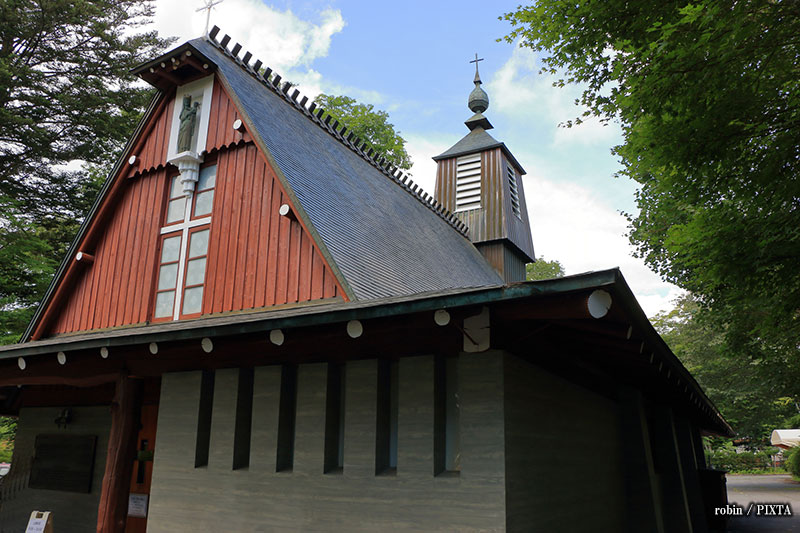
Photo for illustrative purposes
Karuizawa’s role in Japanese culture
One of the most defining aspects of Karuizawa is the integration of Western-style architecture with traditional Japanese elements. This fusion created a distinctive architectural aesthetic that symbolized Japan’s modernization while still preserving its cultural roots. The construction of Western-style villas alongside Japanese gardens, shrines, and temples showcased a harmony between two distinct cultural influences, which remains an iconic feature of Karuizawa today.
Karuizawa’s cultural influence extends beyond architecture. In the early 20th century, it became a hideaway for writers and artists, inspiring a wealth of creative works. Many novelists and painters found inspiration in the town’s serene landscapes and spent time in Karuizawa to capture and draw inspiration from its natural beauty. The town’s peaceful surroundings and rich history have also attracted musicians.
Today, Karuizawa remains a hub for artistic expression. With galleries, cultural events, and music festivals, it continues the legacy of those who have shaped its cultural significance.
Modern-day Karuizawa
Today, Karuizawa remains a top destination for both locals and international visitors, retaining its charm as a relaxing resort town with a blend of modern amenities and natural beauty. Known for its cooler climate, it continues to be a popular escape from the summer heat. The town offers a mix of luxury resorts, high-end shopping, fine dining, and outdoor experiences, making it an ideal retreat for travelers seeking both relaxation and adventure.
Karuizawa’s luxury resorts offer world-class accommodations with stunning mountain views, while boutique shops and designer outlets provide unique shopping opportunities. The fine dining scene features a range of exquisite restaurants serving both traditional Japanese cuisine and international dishes. The surrounding nature also attracts tourists with activities like hiking, cycling, and skiing in the winter months.
Mini travel guide to Karuizawa
How to get there
Getting to Karuizawa is easy and convenient. From Tokyo, you can take the Hokuriku Shinkansen from Tokyo Station. It gets you to Karuizawa in about an hour and fifteen minutes. It’s a fast and comfortable ride, with frequent departures throughout the day. If you’re traveling by car, Karuizawa is about a two-hour drive from Tokyo via the Chuo Expressway. Once you arrive, the town is small and easy to navigate. You can find numerous buses and taxis available to take you around its beautiful spots. So, whether you pick a train or a car, reaching Karuizawa is a smooth journey. For more information, check our detailed transportation guide here.
Top attractions and must-visit spots
Old Karuizawa Ginza Street
This charming street is lined with shops, cafes, and boutiques. It’s perfect for a leisurely stroll while enjoying the town’s unique blend of Western and Japanese architecture.
Kumoba Pond
Known as the “Swan Lake,” Kumoba Pond is a peaceful, scenic spot surrounded by lush greenery. It’s perfect for a relaxing walk or boat ride.
Shiraito Falls
Shiraito Falls is a beautiful waterfall located just outside the town. It offers a serene escape with stunning views and hiking trails.
Mount Asama
This active volcano provides excellent hiking opportunities, especially in the cooler months. It offers panoramic views of the surrounding region.
Karuizawa Prince Shopping Plaza
For those looking to shop, this large outlet mall offers a variety of international and Japanese brands that are perfect for fashion lovers and souvenir hunters.
Outdoor activities
Hiking and cycling
Karuizawa’s mountainous terrain is ideal for hiking and cycling. With various trails, it suits all levels of adventure.
Water sports and winter sports
During summer, lakes like Kumoba Pond offer opportunities for peaceful boat rides and water activities. However, in winter, Karuizawa turns into a ski resort that offers snow sports like skiing and snowboarding.
Dining and accommodations
Karuizawa offers a diverse range of dining options. It is home to everything from casual cafes to fine-dining restaurants. You can enjoy local Japanese dishes, like soba noodles and tempura, as well as international cuisine. Many restaurants feature fresh ingredients from the surrounding mountains and lakes, offering a true taste of the region. For dessert lovers, don’t miss the local ice cream, which is served in many cafés. So, you can find it without much hassle.
For accommodations, Karuizawa has a variety of choices. Luxury resorts offer upscale amenities and stunning views, while cozy Ryokan inns provide traditional Japanese experiences with tatami rooms and hot springs. There are also comfortable hotels and boutique guesthouses. Thus, with several options, Karuizawa makes it easy for any traveler to find the perfect place to stay.
Best time to visit
Though travelers usually visit Karuizawa in the summer, it is a wonderful destination throughout the year. Nature lovers can feel delighted by seasonal attractions in every season, such as cherry blossoms in spring, lush greenery in summer, vibrant foliage in autumn, and ski resorts in winter. Whether you’re seeking peace or adventure, Karuizawa offers something for every type of traveler.
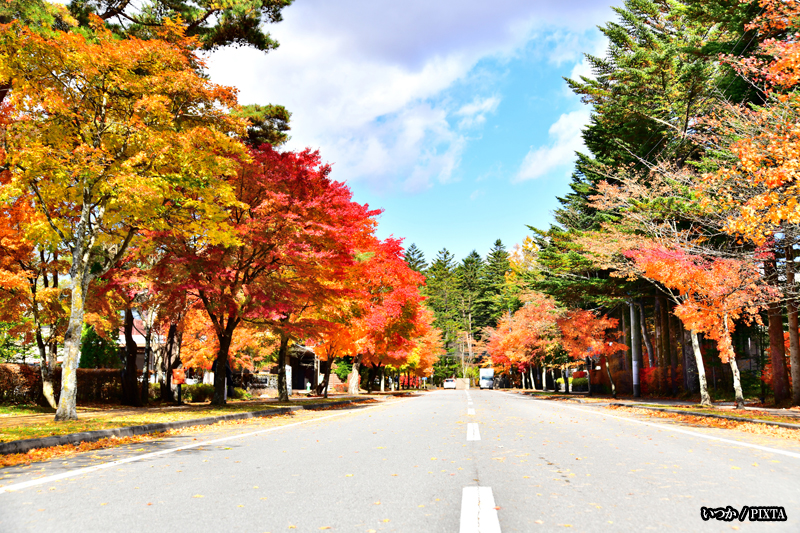
Photo for illustrative purposes
Conclusion
To bring it all together, Karuizawa’s rise as Japan’s leading summer resort is rooted in its transformation from a quiet village to a sought-after retreat for the elite. Thanks to its cool climate, natural beauty, and historical significance, Karuizawa remains a top destination.
As a blend of Western and Japanese influences, alongside its stunning landscapes and variety of outdoor activities, this place continues to captivate visitors from around the world. Its timeless charm as a peaceful escape makes it a lasting favorite for those seeking both relaxation and adventure in a culturally rich setting.
Whether you seek history, luxury, or natural beauty, Karuizawa has it all. With Umami bites, plan your perfect getaway to Karuizawa today!
